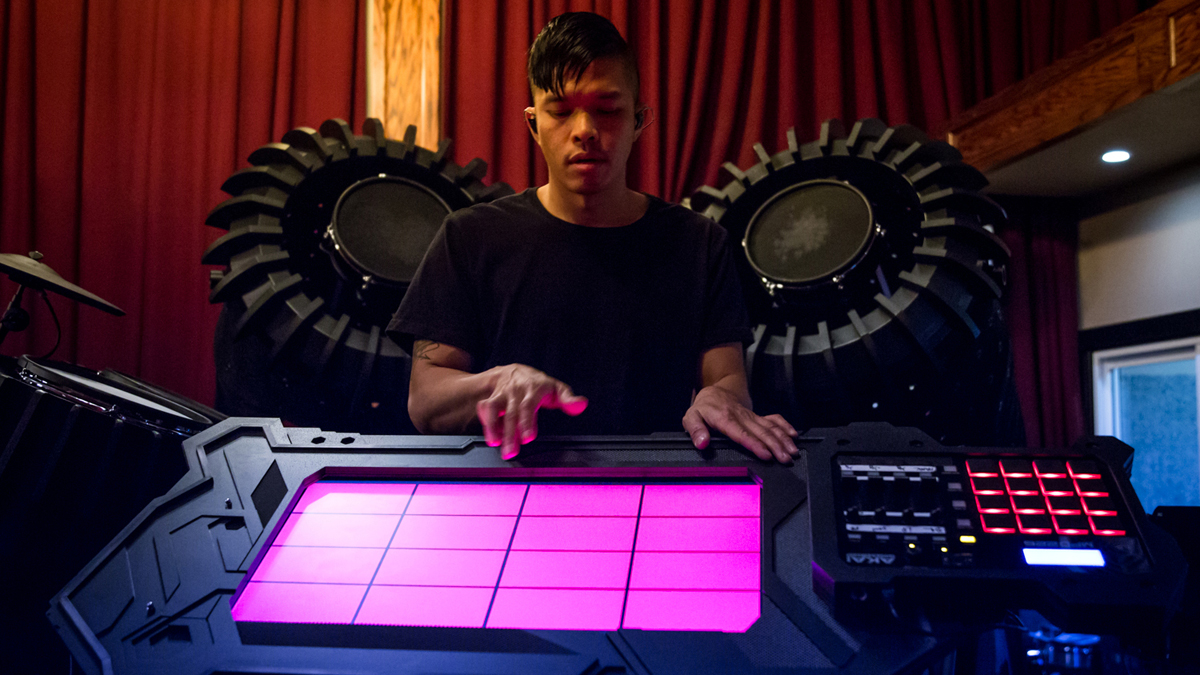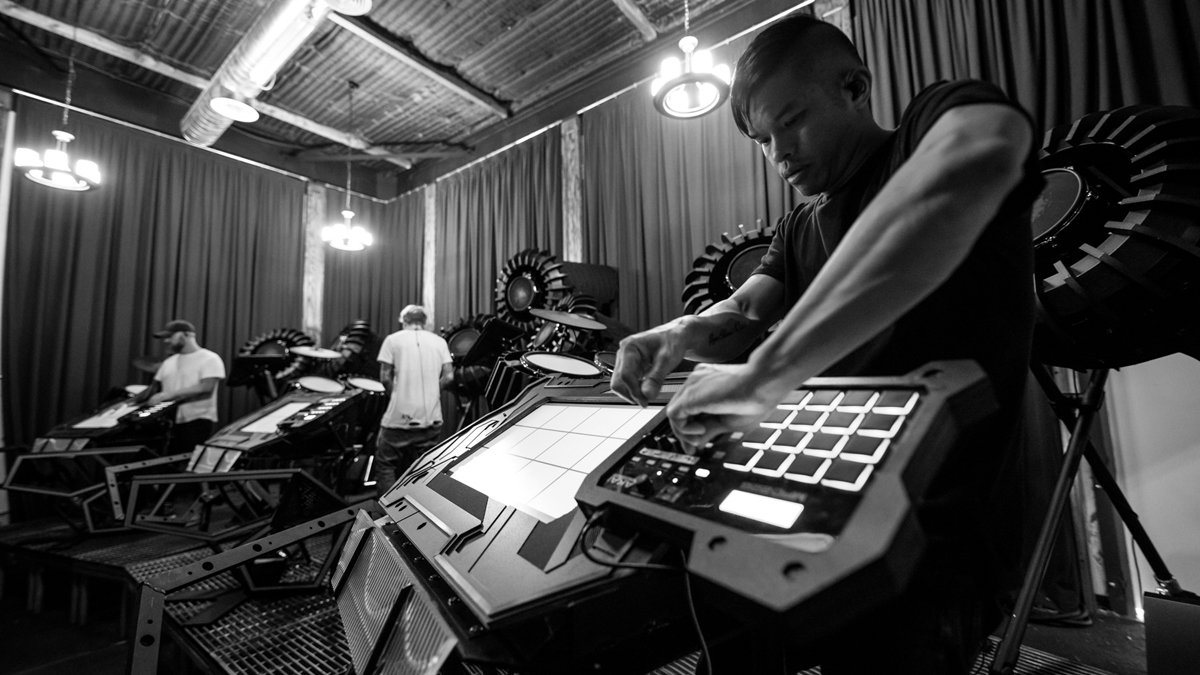The Glitch Mob’s Edward Ma explains how their cutting-edge Blade 2.0 instrument will change the way they perform live
“It’s not something you can buy off the shelf”

IDM trio The Glitch Mob spawned from Los Angeles’ bass-driven ‘beat scene’, debuting in 2010 with the album Drink the Sea. Incorporating elements of dark wave and dubstep, the more chaotic Love Death Immortality LP followed four years later, hitting the number 1 spot on Billboard’s Dance/Electronic album chart.
Despite selling over 300,000 albums via their own Glass Air label, it’s on the live stage where The Glitch Mob made their mark. With the band’s third album See Without Eyes released earlier this month, they’re about to reveal The Blade 2.0 live system, a custom-built ‘instrument’ designed by Martin Phillips, who worked on stage designs for Daft Punk, Kanye and Nine Inch Nails.
The Glitch Mob’s Edward Ma takes us through Blade 2.0’s cutting-edge technology, which is designed to complement their immersive and sonically devastating sound.
The Blade 2.0 is about to be unleashed. Why does the visual aspect of live performance excite you?
“We started out as DJs and have always tried really hard to break down the wall of what’s really happening on stage. There’s always been this long-running joke about what some electronic bands are really doing up there – are they just surfing the internet?"

“I think ever since day one, we’ve always been big on music technology in terms of how far we can push it and breaking down the wall between the performer and the audience. That’s why we’ve tilted our instruments and controllers towards the crowd, so people can actually see what we’re doing. As for why we do it, the bigger question is why not if you can figure out how to bend all this technology to your will?”
Do you or the band have a background in architecture and design?
Want all the hottest music and gear news, reviews, deals, features and more, direct to your inbox? Sign up here.
“Not at all - we’re just studio rats who are fascinated by music technology. We’ve worked with some extremely talented people on The Blade.
We’ve always been big on music technology in terms of how far we can push it and breaking down the wall between the performer and the audience.
“Martin Phillips, who is famous for the Deadmau5 cube, the Kanye mountain and the Daft Punk pyramid, really helped us with the aesthetic vision. We’ve been working with Martin for 10 years; he helped us conceive The Blade and the tour cycle before that. He gets what we’re trying to do, and as far as the custom instrument/controller side of things, we’ve been really lucky to have Nerdmatics on our team over the past five years. They specialise in Ableton playback systems and helped us on the Max MSP side.
“There’s a lot of custom stuff under the hood that makes The Blade 2.0 possible. It’s not something you can buy off the shelf at Guitar Center; it’s like a complex organism with a lot of moving parts.”
We read that you’ve been waiting for technology to catch up with the ideas you have?
“That relates to the horsepower of the computers. For this tour cycle, we partnered with Dell and are using all of their hardware. For playback, we’re using Dell Alienware 15s, which have the Intel Core i7-7820HK quad-core processors. We have all those overclocked to the max running a 50GB Ableton set at a 128 buffer, and while they can do it, we’re still far from where we want to be. It would be great if we could play every single instrument rack that was used when we wrote these songs in Ableton live, as opposed to having to play them back as samples.
“In that regard, the technology is still light years away from being able to play three albums’ worth of songs with actual soft synths and instrument racks on a laptop.”
When do you think that could be possible?
“It could be possible in 10 years if we can get to the point where audio software can take advantage of GPU processing power. On the touchscreen side of things, it’s the same deal. Having the right machines with enough GPU to power 27-inch touchscreens is not easy. We’re using Alienware 17s that have 8GB GTX1080 Max-Qs inside of them; we tried to run the Max patches on lesser-powered machines but they couldn’t cut it.
It would be great if we could play every single instrument rack that was used when we wrote these songs in Ableton live, as opposed to having to play them back as samples.
“I think there’s a big bottleneck with technology right now, which is crazy because we’re pretty much running the most powerful stuff that we can run that’s not some desktop computer.”
Why is it not possible to use desktops rather than laptops?
“The main thing is that you can’t take a desktop rack-mounted PC across the pond easily. It weighs 70lbs without any additional drives, so it’s not easy to put on a plane. There has to be a compromise between having equipment that is easy enough to travel around the world with that’s also durable enough to withstand the trip. I’m sure we could build some really mean desktops, but even if were running i9 7980XEs, which we do have at the studio, we’d still not be able to play three albums’ worth of instruments.”
We understand that The Blade 2.0’s shell was actually designed by a movie set company?
“Yeah, Martin works very closely with a guy called Gregg Lacey who used to work for a company called Vision Scenery, which designs props for mostly sci-fi Hollywood movies – I think they worked on some Terminator and Alien stuff. Gregg understands how to make something look a specific way and how to piece everything together and take it apart so it can fit on a semi-truck.”

You all have your own little workstations within the rig - what do these comprise of?
“As far as the hardware that’s in there is concerned, most of it’s the same. What you’re looking at is three Dell Canvas 27-inch touchscreens, which you can look at as our MIDI controllers to play melodies and kick and snare drum patterns. Nerdmatics wrote these Max patches and put them on there through a series of objects inside of Max called Mira, which essentially allows you to put a frame around a specific portion of your Max patch and cast that either onto an iLet, Android device or even a web browser. We have an Alienware 17 plugged in via a MIDI HDMI cable about 10 feet off stage, and on that we cast a specific portion of the patch onto the canvases. But what’s really crazy about the Mira object is that if we connect The Blade 2.0 up to the Internet, somebody on the opposite side of the world could actually play it remotely.”
It’s funny how the touchscreens are tilted away from you rather than towards you...
“It’s quite comfortable and ergonomic. I think it’s better than playing something where the controller is flat on the table because you’re not hunched over it. When it’s at a 45-degree angle, your arms glide over the canvas and it feels very natural.”
What about drums?
“We have all these crazy turbine-looking drum things and inside of those are Roland PD-125X V-Drum Mesh Snares. We hook all those up to a Roland Octapad, which all three of us have sitting about 10 feet behind us.”
How well-rehearsed do you have to be not to overlap what each other are doing?
“Extremely well-rehearsed. We recently played South by Southwest, which was the first show we’d played in two years. When you don’t play music with your bandmates for that long, it’s amazing how bad you get, so rehearsal is crucial. We rehearsed for three weeks straight, and because we have toured through two tour cycles now, it was a bit like riding a bike - except for all the new songs.”
What happens if something does go down?
“We do have a redundant system. There’s an Alienware 15 fully maxed playing back the 50GB Ableton set, but right next to it is an identical machine playing back at the same time. All the channels are there on the second rig, but you won’t hear it unless the first rig fails, in which case there would probably be less than a second of dropout. We also use these super-small Akai MPD226 controllers, because they have some tactical sliders and faders and can be used as backup in case the canvases go down.”
Is it possible to design and run The Blade 2.0 and still make a profit playing live?
“That’s the golden question. Most electronic artists these days make their money from touring, but we’re the exact opposite - we don’t make any money from touring. It’s a very expensive operation, but strangely enough we’re one of those rare artists that still makes money from iTunes and record sales. Thanks to our devoted fan base, we make our living the old-school way.”
Do you write music with the live show in mind or is the show retrofitted to the music?
“Now when we write music, we absolutely think about how it’s going to be performed with The Blade 2.0 in mind. We consider some songs to be ‘Blade-fuel’ and write specific sections to help move the energy from point A to B. Everything starts from a place of emotion and the story we’re trying to tell as opposed to a tempo with specific drops and risers. With the new album, See Without Eyes, we’ve doubled down really hard on that.”
The Glitch Mob’s new album See Without Eyes is out now on Glass Air. For more information, visit the band’s Facebook page.